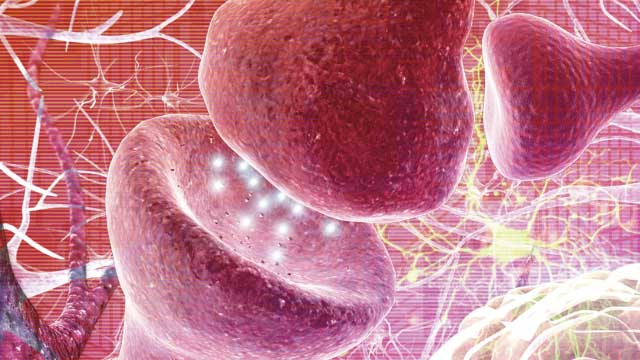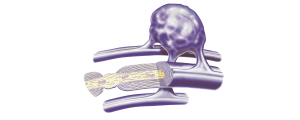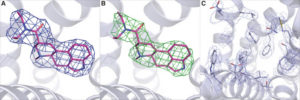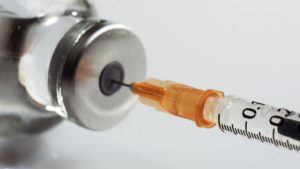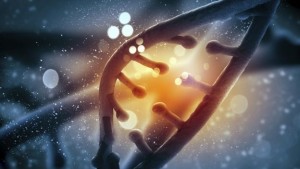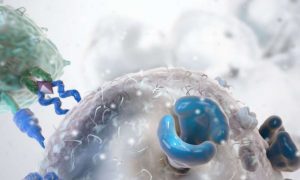Spinal cord injury (SCI) often causes severe and permanent disabilities due to the regenerative failure of severed axons. Here we report significant locomotor recovery of both hindlimbs after a complete spinal cord crush. This is achieved by the unilateral transduction of cortical motoneurons with an AAV expressing hyper-IL-6 (hIL-6), a potent designer cytokine stimulating JAK/STAT3 signaling and axon regeneration. We find collaterals of these AAV-transduced motoneurons projecting to serotonergic neurons in both sides of the raphe nuclei. Hence, the transduction of cortical neurons facilitates the axonal transport and release of hIL-6 at innervated neurons in the brain stem. Therefore, this transneuronal delivery of hIL-6 promotes the regeneration of corticospinal and raphespinal fibers after injury, with the latter being essential for hIL-6-induced functional recovery. Thus, transneuronal delivery enables regenerative stimulation of neurons in the deep brain stem that are otherwise challenging to access, yet highly relevant for functional recovery after SCI.
Introduction
Neurons of the adult mammalian central nervous system (CNS) do not naturally regenerate injured axons. This regenerative failure often causes severe and permanent disabilities, such as para- or tetraplegia after spinal cord injury. To date, no cures are available in the clinic, underscoring the need for novel therapeutic strategies enabling functional recovery in respective patients.
Besides an inhibitory environment for axonal growth cones caused by myelin or the forming glial scar, the lack of CNS regeneration is mainly attributed to a developmental decline in the neuron-intrinsic growth capacity of axons per se1,2,3. Among all descending pathways, the corticospinal tract (CST), which controls voluntary fine movements, is the most resistant to regeneration. Despite numerous efforts aiming to facilitate the CST’s axon regrowth over the last decades, such as the delivery of neurotrophic factors4,5,6 or neutralizing inhibitory cues7,8,9, success has remained very limited. However, the conditional genetic knockout of the phosphatase and tensin homolog (PTEN−/−) in cortical motor neurons, which leads to an activation of the phosphatidylinositol-3-kinase/protein kinase B (PI3K/AKT)/mTOR signaling pathway, enables some regeneration of CST axons beyond the site of injury10. Although this approach facilitated the most robust anatomical regeneration of the CST after a spinal cord crush (SCC) so far10, it fails to improve functional motor recovery11.
In the optic nerve, the activation of the Janus kinase/signal transducer and activator of transcription 3 (JAK/STAT3) pathway stimulates the regeneration of CNS axons12,13. JAK/STAT3 activation is achieved via the delivery of IL-6- type cytokines such as CNTF, LIF, IL-6, and/or the genetic depletion of the intrinsic STAT3 feedback inhibitor suppressor of cytokine signaling 3 (SOCS3)12,14,15,16,17. However, the low and restricted expression of the cytokine-specific α-receptor subunits in CNS neurons required for signaling induction limits the pro-regenerative effects of native cytokines. For this reason, a gene therapeutic approach was recently developed using the designer cytokine hyper-interleukin-6 (hIL-6), which consists of the bioactive part of the IL-6 protein covalently linked to the soluble IL-6 receptor α subunit18. In contrast to natural cytokines, hIL-6 can directly bind to the signal-transducing receptor subunit glycoprotein 130 (GP130) abundantly expressed by almost all neurons19,20. Therefore, hIL-6 is as potent as CNTF but activates cytokine-dependent signaling more effectively18. In the visual system, virus-assisted gene therapy with hIL-6, even when applied only once postinjury, induces more robust optic nerve regeneration than a pre-injury induced PTEN knockout (PTEN−/−)18. Hence, this treatment is the most effective approach to stimulate optic nerve regeneration when applied after injury.
The current study analyzed the effect of cortically applied AAV-hIL-6 alone or in combination with PTEN−/− on functional recovery after severe SCC. A one-time unilateral injection of AAV-hIL-6 applied after SCC into the sensorimotor cortex promoted regeneration of CST-axons stronger than PTEN−/−, and, additionally, serotonergic fibers of the raphespinal tract, which enabled locomotion recovery of both hindlimbs. Moreover, we demonstrate that cortical motoneurons project collaterals to serotonergic raphe neurons deep in the brain stem, allowing the release of hIL-6 to induce regenerative stimulation of serotonergic neurons. Thus, transneuronal stimulation of neurons located deep in the brain stem using highly potent molecules might be a promising strategy to achieve functional repair in the injured or diseased human CNS.
Results
Hyper-IL-6 and PTEN knockout activate different signaling pathways
To investigate the impact of hIL-6 and PTEN−/− on regeneration associated signaling pathways in motoneurons, we applied either AAV2-hIL-6 (GFP coexpression), AAV2-Cre (GFP coexpression), or AAV2-GFP into the sensorimotor cortex of adult PTEN-floxed mice. Viral transduction affected mainly layer V neurons in the primary motor cortex, adjacent to the injection sites (Fig. 1a–c and Fig. S1a–e). Moreover, only AAV-hIL-6 transduced cells showed the hIL-6 protein (Fig. S1f, g). Western blot analysis verified these results, detecting hIL-6 in respective tissues of AAV-hIL-6 treated animals only (Figs. S1h, i, S15d, e, S16n, o). In contrast to AAV2-Cre (PTEN−/−) and AAV2-GFP, AAV2-hIL-6 application induced strong STAT3-phosphorylation as shown in sections of cortical tissue and western blot lysates (Fig. 1b–g, k, m, n, o and Fig. S1j, k). These signals were seen in all GFP-positive hIL-6-transduced neurons and adjacent cells, indicating the paracrine effects of released hIL-6. STAT3 activation was already at its maximum 1 week after injection and remained stable over at least 8 weeks (Fig. 1n, o, Fig. S14a-d, f-h; Fig. S16a), while total STAT3 protein expression was not significantly altered (Fig. 1n, p and Figs. S14f, i-m, Fig. S16b, d). In contrast to PTEN−/−, which induced robust phosphorylation of AKT (pAKT) and S6 (pS6), AAV2-hIL-6 had little impact on the phosphorylation of these proteins (Fig. 1h–l, n, q, r, t and Figs. S14n, S16c, f, g). PTEN−/−-induced phosphorylation of S6 was restricted to GFP-positive (transduced) neurons only (Fig. 1k, l). Neither hIL-6 nor PTEN−/− influenced phosphorylation of ERK1/2 (Fig. 1r, s; Fig. S14 m, o-p and Fig. S16e).

